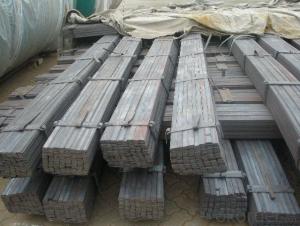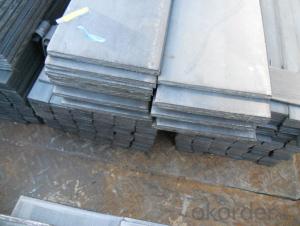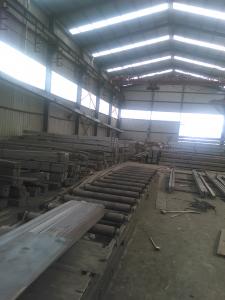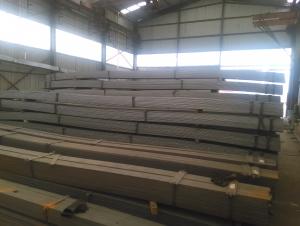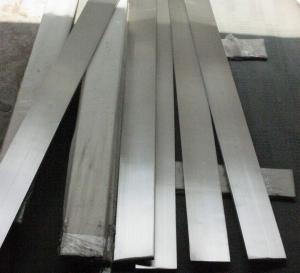Hot Rolled Steel Flat Bar with High Quality
- Loading Port:
- Tianjin
- Payment Terms:
- TT OR LC
- Min Order Qty:
- 25 m.t.
- Supply Capability:
- 10000 m.t./month
OKorder Service Pledge
OKorder Financial Service
You Might Also Like
Product Description:
OKorder is offering high quality Slit Cutting Flat Bar at great prices with worldwide shipping. Our supplier is a world-class manufacturer of steel, with our products utilized the world over. OKorder annually supplies products to European, North American and Asian markets. We provide quotations within 24 hours of receiving an inquiry and guarantee competitive prices.
Product Applications:
Slit Cutting Flat Bars are ideal for structural applications and are widely used in the construction of buildings and bridges, and the manufacturing, petrochemical, and transportation industries.
Product Advantages:
OKorder's Slit Cutting Flats Barare durable, strong, and resist corrosion.
Main Product Features:
· Premium quality
· Prompt delivery & seaworthy packing (30 days after receiving deposit)
· Corrosion resistance
· Can be recycled and reused
· Mill test certification
· Professional Service
· Competitive pricing
Product Specifications:
Manufacture: Slit Cutting
Grade: Q195 – 235
Certificates: ISO, SGS, BV, CIQ
Length: 6m – 12m, as per customer request
Packaging: Export packing, nude packing, bundled
Chemical composition of Q235
Alloy No | Grade | Element(%) | ||||
C
| Mn
| S
| P
| Si
| ||
Q235
|
B
|
0.12—0.20 |
0.3—0.7 |
≤0.045 |
≤0.045
|
≤0.3
|
Physical properties of Q235
Alloy No | Grade | Yielding strength point(Mpa) | Tensile strength (Mpa) | Elongation after fracture(%) | ||||||
Thickness (mm) | Thickness (mm) | |||||||||
≤16 | >16--40 | >40--60 | >60--100 | ≤16 | >16--40 | >40--60 | >60--100 | |||
≥ | ≥ | |||||||||
Q235 |
B |
235 |
225 |
215 |
205 |
375--500 |
26 |
25 |
24 |
23 |
FAQ:
Q1: How soon can we receive the product after purchase?
A1: Within three days of placing an order, we will begin production. The specific shipping date is dependent upon international and government factors, but is typically 7 to 10 workdays.
Q2: How do we guarantee the quality of our products?
A2: We have established an advanced quality management system which conducts strict quality tests at every step, from raw materials to the final product. At the same time, we provide extensive follow-up service assurances as required.
Q3: The products are invoicing on theoritical weight or on actual weight?
A3: We can do it in both manners, it 's according to the customers' requirement.
Images:
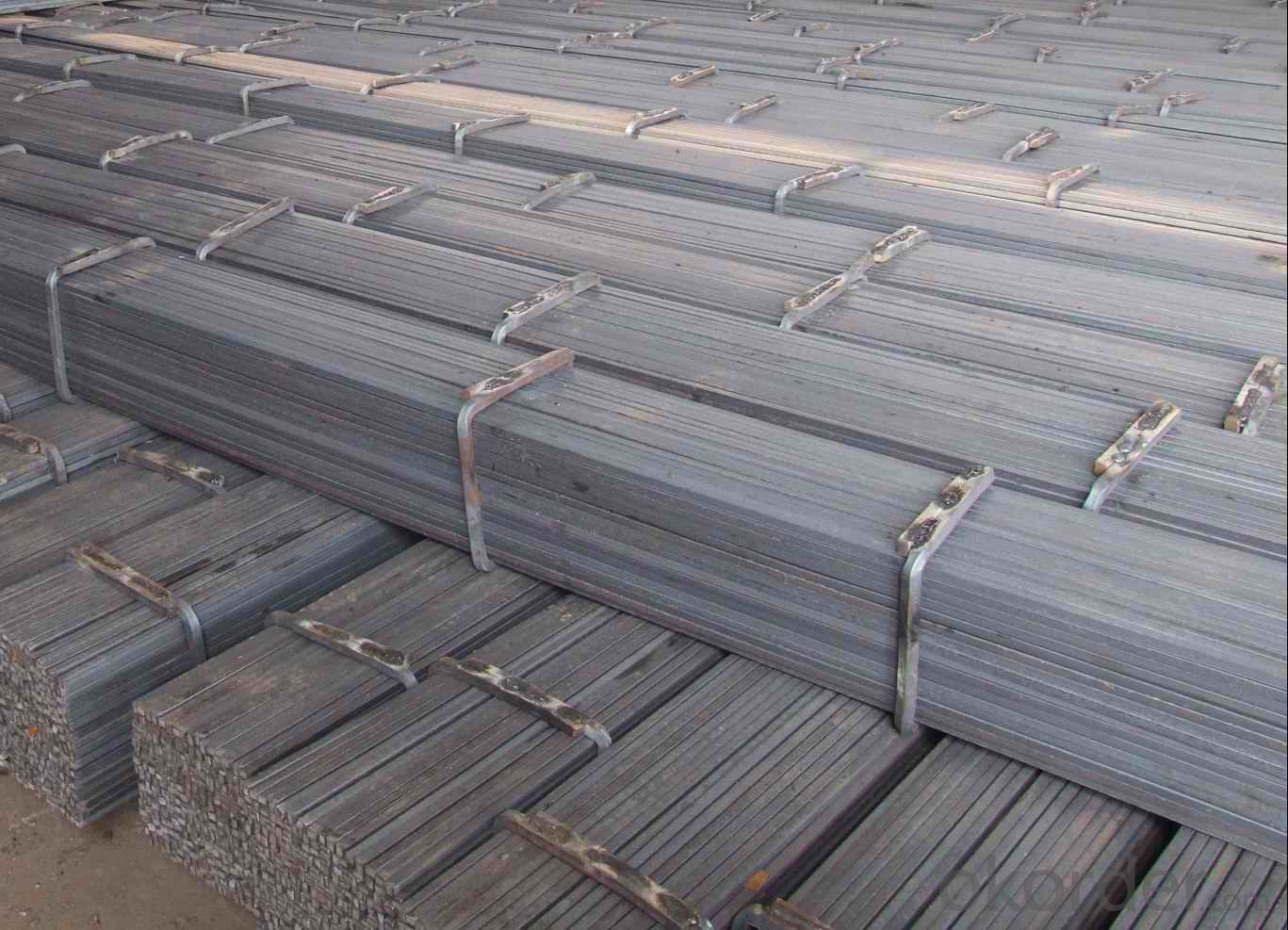
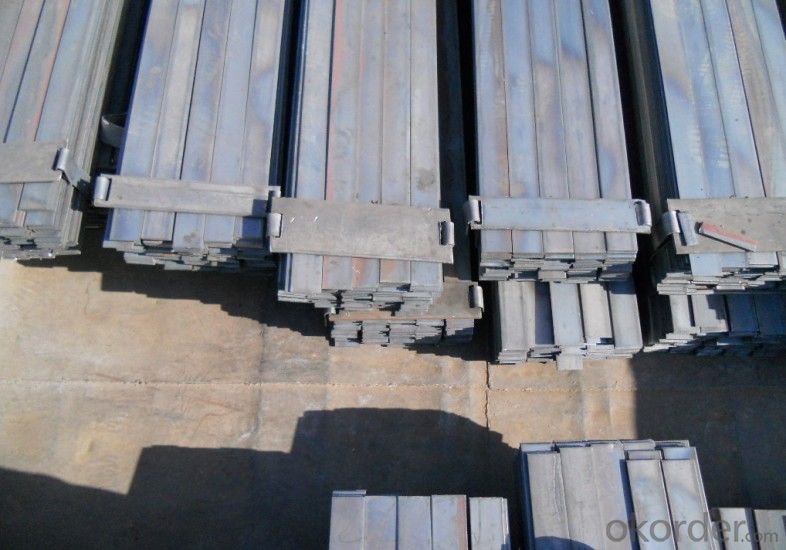
- Q:Can steel flat bars be used for manufacturing kitchen equipment?
- Yes, steel flat bars can be used for manufacturing kitchen equipment. Steel is a commonly used material in the manufacturing of kitchen equipment due to its strength, durability, and resistance to corrosion. Steel flat bars can be easily formed and shaped into various kitchen equipment components such as shelves, racks, countertops, and supports. Additionally, steel flat bars can be welded or joined together to create larger structures or frameworks for kitchen equipment. The versatility and reliability of steel make it an excellent choice for manufacturing kitchen equipment that can withstand heavy usage and provide long-lasting performance.
- Q:How do steel flat bars compare to plastic flat bars?
- Steel flat bars have several advantages over plastic flat bars. Firstly, steel is significantly stronger and more durable than plastic. This means that steel flat bars can withstand heavier loads and are less likely to break or bend under pressure. Additionally, steel is highly resistant to wear and tear, making it a more long-lasting option compared to plastic, which can warp or degrade over time. Furthermore, steel flat bars offer better heat resistance than plastic. They can withstand higher temperatures without deforming or losing their structural integrity. This makes steel flat bars suitable for applications where heat exposure is a concern, such as in industrial or construction settings. In terms of aesthetics, steel flat bars also have an advantage. Their smooth and polished surface provides a sleek and professional look, while plastic flat bars may have a more rough or textured appearance. However, it is worth noting that plastic flat bars have their own advantages. Plastic is lightweight, making it easier to handle and transport. It is also corrosion-resistant, which can be beneficial in environments where exposure to moisture or chemicals is a concern. Additionally, plastic flat bars are non-conductive, making them suitable for electrical or electronic applications where the risk of electrical shock is a consideration. Ultimately, the choice between steel and plastic flat bars depends on the specific requirements of the application. While steel flat bars offer superior strength, durability, and heat resistance, plastic flat bars may be more suitable for certain situations due to their lightweight, corrosion-resistant, and non-conductive properties.
- Q:What is the maximum length available for steel flat bars?
- The maximum length available for steel flat bars can vary depending on the supplier and manufacturer. However, typically, steel flat bars are available in lengths ranging from 20 feet to 40 feet.
- Q:What are the standard tolerances for width and thickness in steel flat bars?
- The standard tolerances for width and thickness in steel flat bars vary depending on the specific industry and application. However, commonly accepted tolerances for width range from +/- 0.005 to +/- 0.030 inches, while tolerances for thickness typically fall within +/- 0.002 to +/- 0.020 inches. It is important to consult the relevant industry standards or manufacturer specifications for precise tolerances required for a specific steel flat bar.
- Q:Can steel flat bars be used in the manufacturing of machinery components?
- Yes, steel flat bars can be used in the manufacturing of machinery components. Steel is widely used in the manufacturing industry due to its strength, durability, and versatility. Steel flat bars are commonly used in the construction of machinery components such as brackets, supports, frames, and base plates. They provide a strong and stable foundation for various machinery parts and can withstand heavy loads and high pressures. Additionally, steel flat bars can be easily machined, welded, and shaped into specific dimensions, making them ideal for the production of custom machinery components. Overall, steel flat bars are a reliable and cost-effective choice for manufacturing machinery components.
- Q:Can steel flat bars be used in the construction of bridges?
- Yes, steel flat bars can be used in the construction of bridges. Steel is widely used in bridge construction due to its high strength, durability, and ability to withstand heavy loads. Steel flat bars are commonly used as structural members in bridge construction, especially for beams, girders, and piers. They provide excellent support and stability, allowing bridges to span long distances and carry heavy traffic loads. Additionally, steel flat bars can be customized and fabricated to specific sizes and shapes, making them versatile and suitable for various bridge designs. Overall, steel flat bars are an essential component in bridge construction, contributing to the strength, safety, and longevity of the structures.
- Q:What are the different surface treatments for steel flat bars?
- Steel flat bars have various options for surface treatments that serve different purposes. These treatments aim to enhance appearance, prevent corrosion, increase durability, and provide specific functionalities. Hot-dip galvanizing is an effective treatment for outdoor applications. It involves immersing the bars in molten zinc, forming a protective coating against corrosion caused by moisture, chemicals, and harsh weather conditions. Powder coating, on the other hand, is a dry finishing process. It includes applying a resin and pigment powder onto the bars, which melts when heated. This creates a long-lasting, decorative, and corrosion-resistant coating. Powder coating is popular for its wide range of colors and finishes. Electroplating is a process that coats the bars with a metal layer through electrochemical means. Common metals used are chrome, nickel, and zinc. It improves appearance, corrosion resistance, and wear resistance. Passivation is a chemical treatment specifically for stainless steel bars. It removes iron particles and contaminants, creating a protective oxide layer that prevents rusting and enhances corrosion resistance. Anodizing is typically used for aluminum bars, but it can also be applied to steel bars. This process involves creating a controlled oxide layer on the surface through electrochemical means. It improves corrosion resistance, hardness, and appearance. Painting is a common treatment for indoor applications. The bars are coated with paint, providing an attractive finish and protection against corrosion. Different colors and finishes can be used to meet specific aesthetic requirements. When choosing a surface treatment, it is crucial to consider the application and environment. Each treatment offers unique benefits and characteristics that can be customized to meet appearance, performance, and durability requirements.
- Q:How do steel flat bars compare to stainless steel flat bars?
- Steel flat bars and stainless steel flat bars differ in their composition and properties. Steel flat bars are typically made from carbon steel, which provides strength and durability but is susceptible to rust and corrosion. On the other hand, stainless steel flat bars are made from an alloy that contains chromium, which offers excellent corrosion resistance. Stainless steel flat bars are also known for their aesthetic appeal and are commonly used in applications where hygiene and appearance are important, such as in the food industry or architectural projects. Overall, stainless steel flat bars are a superior option in terms of corrosion resistance, while steel flat bars are more affordable and suitable for applications where corrosion resistance is not a primary concern.
- Q:What are the different cleaning and maintenance methods for steel flat bars?
- There are several cleaning and maintenance methods for steel flat bars that can help keep them looking and performing their best. Some of the most common methods include: 1. Regular Cleaning: The first step in maintaining steel flat bars is regular cleaning. This can be done using a mild detergent or soap and water solution. Simply apply the solution to the surface of the flat bar and use a soft cloth or sponge to gently scrub away any dirt or grime. Rinse the bar thoroughly with clean water and dry it using a soft, lint-free cloth. 2. Polishing: Polishing the steel flat bars can help restore their shine and remove any surface scratches or marks. There are various metal polishes available in the market specifically designed for stainless steel surfaces. Apply a small amount of polish to a microfiber cloth and rub it onto the surface of the flat bar in circular motions. Continue polishing until the desired shine is achieved. 3. Stainless Steel Cleaner: For tougher stains or marks that regular cleaning cannot remove, a stainless steel cleaner can be used. These cleaners are designed to break down and remove stubborn stains, grease, and grime from stainless steel surfaces. Follow the instructions on the cleaner's packaging for best results. 4. Rust Prevention: Steel flat bars are susceptible to rust, especially in humid or corrosive environments. To prevent rust, it is important to keep the flat bars dry and avoid prolonged exposure to moisture. If any rust spots do appear, they should be promptly removed using a rust remover or a mixture of vinegar and baking soda. After removing the rust, clean and dry the flat bar thoroughly to prevent further rusting. 5. Protective Coatings: Applying a protective coating or sealant to steel flat bars can help enhance their resistance to staining, corrosion, and scratches. There are various products available such as clear lacquers, paints, or specialized coatings specifically designed for stainless steel surfaces. Follow the manufacturer's instructions for proper application and maintenance of the protective coating. By following these cleaning and maintenance methods, steel flat bars can maintain their appearance and durability for a longer period of time, ensuring optimal performance in various applications.
- Q:What are the standard lengths of steel flat bars?
- The standard lengths of steel flat bars can vary depending on the manufacturer and the specific requirements of the project. However, there are commonly available standard lengths that are widely used in the industry. These standard lengths typically range from 6 feet to 20 feet. Some manufacturers may also offer longer lengths, such as 24 feet or even custom lengths, but these are less commonly used. It is important to note that steel flat bars can also be cut and customized to specific lengths based on the needs of the project.
1. Manufacturer Overview |
|
|---|---|
| Location | |
| Year Established | |
| Annual Output Value | |
| Main Markets | |
| Company Certifications | |
2. Manufacturer Certificates |
|
|---|---|
| a) Certification Name | |
| Range | |
| Reference | |
| Validity Period | |
3. Manufacturer Capability |
|
|---|---|
| a)Trade Capacity | |
| Nearest Port | |
| Export Percentage | |
| No.of Employees in Trade Department | |
| Language Spoken: | |
| b)Factory Information | |
| Factory Size: | |
| No. of Production Lines | |
| Contract Manufacturing | |
| Product Price Range | |
Send your message to us
Hot Rolled Steel Flat Bar with High Quality
- Loading Port:
- Tianjin
- Payment Terms:
- TT OR LC
- Min Order Qty:
- 25 m.t.
- Supply Capability:
- 10000 m.t./month
OKorder Service Pledge
OKorder Financial Service
Similar products
New products
Hot products
Related keywords
